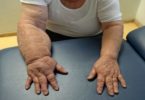Keep your age a secret with targeted anti-aging beauty tips and tricks from the pros!
There are plenty of steps you can take to get healthier, more even, younger looking skin.
Some of the best solutions for healthy skin come from leading a healthy lifestyle and improving your skin’s appearance from the inside out.
- Vertical wrinkles around the mouth are mechanically etched into our faces whenever we talk, laugh, or eat. While you can’t stop the etching, you can slow it down by applying sunscreen regularly and using a collagen booster or a wrinkle-fighting treatment around your mouth daily. Try a product that contains hyaluronic acid (to plump up fine lines) or madecassoside (an ingredient that sinks in to repair cell damage).
- Dry or flaky lips look thinner and more wrinkled than they are, so get on the balm bandwagon. Restoring moisture is the key to keeping lips looking smooth, even, and full. Try a rich balm, a lip treatment, or a healing gloss with color.
- Fight fine lines on hands with alpha hydroxy acid (or AHA) masks and at-home peels. Applied to the top of hands, these products slough off dull, dead skin and help speed cell turnover. When the new, healthy cells reach the surface, they give skin a smoother texture, making lines and wrinkles less noticeable.
- Lighten age spots with the bleaching agent hydroquinone. Available in stores or by prescription, it works by interfering with an enzyme that helps skin produce melanin, the brown pigment that shows up as spots. Find it over the counter in concentrations up to 2 percent; prescription versions usually have 4 percent. Our expert recommends using hydroquinone in conjunction with a prescription-strength retinoid, such as Renova or Tazorac, which helps lighten by exfoliating the skin.
- Fight lines and wrinkles around the eyes with a few essential ingredients. The first is retinol, a vitamin A derivative that rebuilds collagen levels and helps smooth fine lines. Next are antioxidants like green tea and vitamin C, which help skin retain collagen. If your skin is especially sensitive, swap vitamin A products for peptides proteins that also stimulate collagen growth because they don’t sting or cause redness the way retinols can.
- Retinoids are great for fine lines on the face, but it’s tough to deal with the potential side effects, such as redness and peeling skin, although skin will build up a tolerance, usually within six to 12 weeks. Retin-A is the gold standard in prescription strength, though there are several less-irritating options costing $100 per tube on average including Retin-A Micro, Differin, Avage, and Tazorac. Dermatologists suggest you ease into using one: Apply a pea-size amount at night (sun exposure makes retinoids less effective), and try it every second or third night until your skin handles it better. If that’s still too irritating, use an over-the-counter formula, which is less potent but still effective.
- No eye cream alone will reverse sagging lids once skin begins its downward slide. But artfully applied eye makeup can make drooping lids less noticeable. “The trick is to define the lashline and neutralize the lid,” says celebrity makeup artist Sandy Linter. Apply a light, nude-colored shadow (like cream or mocha, depending on skin tone) from lashes to brow. Next, dip a liner brush in a gray, brown, or black shadow, and apply color as close to the base of top lashes as possible. Shadow creates a softer, more natural look than a pencil liner. Finish with dark-brown or black mascara.
- Avoid skin-care products that contain SD-40, isopropyl alcohol, a common ingredient that can be an irritant for acne-prone and sensitive skin types, leading to redness, dryness, and in some cases, brown spots and premature aging.
- Don’t overexfoliate. Many products today have alpha hydroxy acids to combat wrinkles and fine lines, but if you mix-and-match too often for example, an acid-based moisturizer in the morning and an exfoliating cream at night you run the risk of inflaming your skin.
- Over-the-counter exfoliators won’t shrink pores, but they may help them appear less noticeable. Try a serum or peel with salicylic acid which chemically clears out dirt, oil, and cell buildup and glycolic or lactic acid to slough and soften the surface.
- Women with dry skin (which often happens with age) should avoid overmoisturizing, so don’t spackle on cream or heavy moisturizers. Instead, invest in a good humidifier, especially if you live in a dry climate.
- Get plenty of sleep. Skin repairs itself at night, so if you’re routinely sleep-deprived, your complexion will show it.
-
Fight inflammation with calming ingredients such as white and green tea extracts, which provide immediate improvement for aging- and rosacea-related redness.





